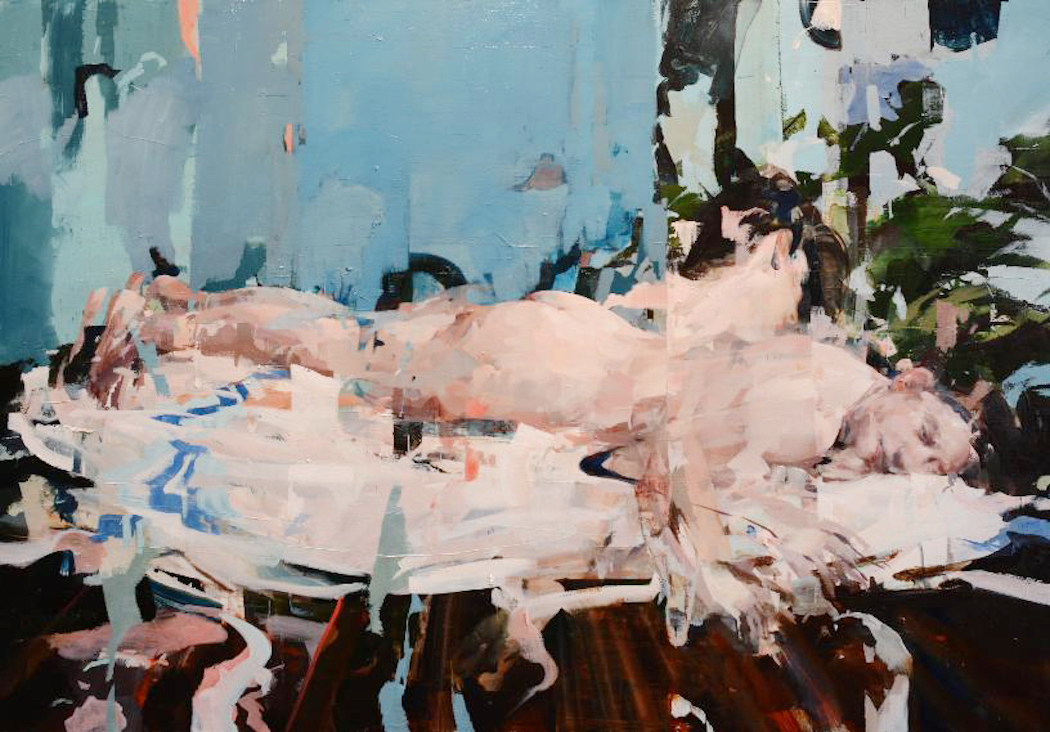by David M. Roth
Alex Kanevsky | Conversation, 2015 | Oil on canvas | 46.5 x 66 inches
One thing we can say for certain about the Lithuania-born painter Alex Kanevsky is that he is an unabashed romantic. He paints with a bravura technique and uses its seductions to disarm viewers like me who tend to dismiss painting that issues its appeal in purely “retinal” terms. His main subjects are women in dishabille. They appear on beds and on beaches and in empty rooms and pools – languorously posed in places where radiant sunlight, azure waters and crumpled sheets call to mind playgrounds of the superrich. However Kanevsky is not making any kind of social or political statement. He is above all else a sensualist and a formalist. He paints to describe the eternal tug-o-war between the tangible and the ineffable, and, more specifically, to chart how bodies behave at different points on that continuum.
A quick glance at the artist’s recent output shows him to be actively engaged with European masters, chief among them Seurat, Manet, Ingres, Bacon, Freud, Soutine and Auerbach. In summoning them, his objective, it appears, is to drag their sensibilities into the present by merging them with his own. This he does by messing with traditional figure/ground relationships and by superimposing onto them, painterly artifacts that mimic the sorts of digital detritus that appears on TV sets when the cable signal runs amok. Granted, this an all-too-common mannerism among digital painters, a group to which Kanevsky definitely does not belong. But, as we learn from Unstable Equilibrium, the Philadelphia artist’s sixth show at the gallery, past and present are easily entangled, and that is all to the good because it renders fresh important parts of history that are fast being paved over in the rush to digital oblivion.

Alex Kanevsky | JWI In Her Room, 2015 | Oil on panel | 48 x 44 inchesHis strongest works appear draped in a multi-layered mist, as if plucked from a dream where some parts appear real enough to touch, while others remain disconcertingly out of reach. Those that seem most real have to do with flesh. He depicts it by conjoining overlapping swatches of thick pigment in tones ranging from white and pink to beige, brown and black. The effect in Beautiful Ladies Drinking Tea in Landscape, a triptych, is carnal, and in ways that extend beyond mere eroticism. It shows five nudes sprawled on a windswept bluff lashed by waves painted in a mix of mottled blues. What pushes the painting beyond post-Impressionism is the way Kanevsky fractures the heads and dissolves them into the raging surf. He also he depicts, in the manner of Bacon, one of the women’s limbs as if it were slab of beef, cleaved to reveal a marbled cross section. Overall, the picture pulls in opposite directions; it is at once enervated and violent, blasé and passionate – and, more to the point — atomized in a way that, say, Bacon’s contorted, meat-grinder paintings are not. (Though connections to Auerbach do loom large.)
Alex Kanevsky | J.W.I. Twice, 2014 | Oil on panel | 36 x 36 inches
Another effective device, which I’ll call mock-montage for lack of a better term, involves Kanevsky’s insertion of slender horizontal lines into paintings that create the illusion of a narrative. Few such structures exist in the works themselves. But by fostering the illusion that they do, the artist gets you to see things you might otherwise easily miss. For example, hovering inside one “panel” of Conversation is the diaphanous visage of a woman whispering into her sleeping lover’s ear. That it depicts is a “visitation” dream is all but obscured by the sheer amount of plastic activity going on. Much of it involves an adaptation of Soutine’s technique of liquefying things, of making landscapes look like melted wax. Kanevsky, in this and several other paintings, does something similar, but in a brighter, sweeter palette, liquefying and flowing together floorboards, bed sheets, clothing, bodies and background as if they were reflections in water.
Water, in fact, may be Kanevsky’s biggest triumph in this show, the one instance where he actually does create a true multi-part montage. It comes in the form of a seascape built of individually painted segments of Mylar affixed to a six-foot-long panel. Whether they’re made from photos or painted individually on-site, I can’t say. What I do know is that this one, Waves, captures the sensory assault of the ocean better than any work I’ve seen in memory, save the Turners displayed earlier this year at the de Young. Here, Kanevsky tears a page from Richter, laying down multiple layers of semi-translucent paint, scraped horizontally.
To these he adds a lot of frenzied brushwork, which, through some sort of alchemy, reflects light – both gauzy and glaring — back at us. Visible dislocations between the individual segments make for literal slippages, which, in turn, drive us deeper into the details of a scene that all but spews salt spray and the sound of thundering surf.
Are there nits to be picked? Yes, here and there. A little lower fructose content would be desirable in certain works, as would more psychological insight (a la Lucien Freud) into the characters depicted. For the most part, the disequilibrium found in Unstable Equilibrium works just fine.
Alex Kanevsky: “Unstable Equilibrium” @ Dolby Chadwick through October 31, 2015.

